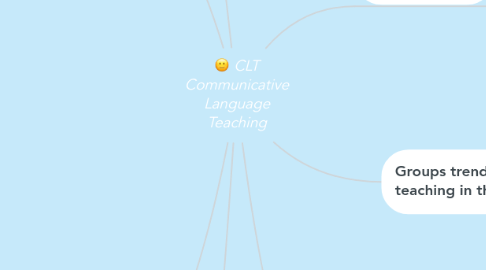
1. Planning language courses within a comunicative approach
1.1. Grammar was no longer the starting point
2. Develop the learner's communicative competence
2.1. Purposes
2.1.1. Wishes of learners to acquire the target language
2.2. Setting
2.2.1. They will want to use the target language
2.3. Role
2.3.1. The learners will assume in the target language, as well as the role of their interlocutors
2.4. Communicative events
2.4.1. The learners will participate: everyday situation, academic situation and so on.
2.5. Language functions
2.5.1. What the learner will be able to do with or through the language
2.6. Notions or concept involved
2.6.1. What the learner will need to be able to talk about
2.7. Discourse and rhetorical skills
2.7.1. "knitting together" (storytelling, giving an effective bussiness presentation)
2.8. Variety
2.8.1. The need of learners of the target language such as American, Australian, or British English, and the levels in the spoken and written language that the learners will need to reach
2.9. Grammatical content
2.9.1. That will be needed
2.10. Lexical content or vocabulary
2.10.1. That will be needed
3. Proposals for a communicative syllabus
3.1. A skill-based syllabus
3.1.1. Listening
3.1.1.1. Microskills
3.1.1.1.1. Identifying key information in a passage
3.1.1.1.2. Following speech at different rates of speed
3.1.1.1.3. Recognizing time reference of an utterance
3.1.1.1.4. Recognizing speakers’ attitude toward a topic
3.1.1.1.5. Recognizing the topic of a conversation
3.1.1.1.6. Recognizing key words in conversations
3.1.2. Reading
3.1.3. Writing
3.1.4. Speaking
3.2. A functional syllabus
3.2.1. Functions the learner should be able to carry out in English
3.2.1.1. Expressing likes and dislikes
3.2.1.2. Offering and accepting apologies
3.2.1.3. Introducing someone
3.2.1.4. Give explanations
3.3. Threshold syllabus
3.3.1. Grammar
3.3.2. Situations
3.3.3. Topics
3.3.4. Functions
3.3.5. Notions
3.3.6. Vocabulary
4. Implications for methodology
4.1. Make real communication the focus of language learning
4.2. Provide opportunities for learners to experiment and try out what they know
4.3. Be tolerant of learners’ errors as they indicate that the learner is building up his or her communicative competence
4.4. Provide opportunities for learners to develop both accuracy and fluency
4.5. Link the different skills such as speaking, reading, and listening together, since they usually occur so in the real world
4.6. Let students induce or discover grammar rules
5. Groups trends in language teaching in the last 50 years
5.1. Traditional approaches (up to the late 1960s)
5.1.1. "Fluency-first" Pedagogy
5.1.1.1. Classic communicative language teaching
5.1.1.1.1. Communicative competence was a broader concept that of grammatical competence
5.1.1.1.2. 1970
5.1.1.2. Current communicative language teaching
6. Planning a language course
6.1. Decisions about vocabulary and grammar to teach in different levels
6.1.1. Decision about how best to teach content of a syllabus
6.1.1.1. Methodology
6.1.2. Decision about issues
6.1.2.1. Syllabus desing
6.1.2.2. Course desing
7. English for specific porposes
7.1. Particular roles or educaational roles
7.1.1. Biologist
7.1.2. Nurses
7.1.3. Engineers
7.1.4. Flight attendant
7.1.5. Pilot
7.2. Differences of the use the language for specific rather
7.2.1. Vocabulary choice
7.2.2. Grammar
7.2.3. Functions
7.2.4. Kinds of texts commonly occurring
7.2.5. Need for particular skills
